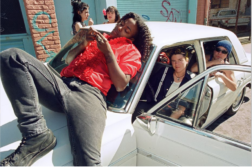J.R.R. TOLKIEN’S CLASSIC WORK of fantasy literature The Hobbit has been enjoyed by millions of readers as a definitive story of escape. The book is equally cherished for the introduction of hobbits, an endearing variation on humanity. But the novel is much more psychologically profound and redolent with sexual symbolism than has been acknowledged by reviewers and Tolkien’s biographers. The distinctly homoerotic yearnings of Bilbo Baggins and the psychosexual pathology of Gollum were not discussed by reviewers in 1937 when the book was first published and hailed as a children’s classic on both sides of the Atlantic. But in the 21st century, Tolkien’s monumental fan base has elevated his works to legendary status, with every character and plot strand dissected with the utmost seriousness. Homosexuality, however, remains the final frontier in the journey toward full appreciation of Tolkien’s vividly original characters.
The origin of The Hobbit was bedtime stories invented by Tolkien for the entertainment of his four children in the late 1920s. Tolkien began writing the manuscript version of The Hobbit in his spare time as professor of Anglo-Saxon at Oxford in around 1930. The story of Bilbo Baggins, the hobbit who joins thirteen dwarves on their quest to reclaim a hoard of treasure from the dragon Smaug, gradually assumed a grander and more complex form as his writing progressed and the story gripped his imagination. The final version, while retaining some of the children’s story elements, is rich with erotic imagery and existential darkness. Bilbo Baggins and the creature Gollum are autobiographical, representing opposite corners of the author’s psyche.
In crafting The Hobbit, the genre Tolkien was aiming for was not so much children’s literature as what he termed “fairy-stories.” Beginning when he was an undergraduate and an aspiring poet at Oxford, Tolkien developed an attachment to the term “fairy,” or “faerie,” which he defined roughly as literature about magical happenings. He came up with the title The Trumpets of Faerie for a volume of his poems completed by 1915. Although warned against using the word by his former teacher R. W. Reynolds, the young writer continued to do so.
The use of the term fairy to denote male homosexuals dates back to the 1890s. By the 1920s, the word was fairly common, often employed in a derogatory sense, as shown in Evelyn Waugh’s Brideshead Revisited (1945) when Charles and Sebastian are taunted. With the passage of time, Tolkien became increasingly enamored of the term. In 1939, two years after The Hobbit was published, he gave a lecture titled “On Fairy-Stories” at St. Andrews University in Scotland. Given that he was a brilliant philologist attuned to the historical and cultural richness of names, places, and individual words, one can only conclude that Tolkien derived considerable satisfaction from the dual meaning of fairy-stories.

David LaFontaine is a professor in the English Department at Massasoit Community College.






